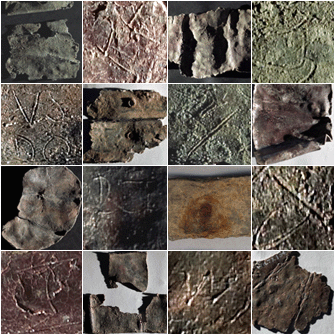
By Dr. A.K. Bowman FBA, Prof. J.M. Brady FRS FEng., Dr. R.S.O. Tomlin FSA, Prof. J.D. Thomas FBA, Research Assistant - Dr J. Pearce
Lead 'curse tablets' comprise thin rectangular sheets which, when complete and unrolled, generally measure 6 - 12cm long and 4 - 8cm wide, although many survive only as fragments. Though often described as 'lead', metallurgical analysis of tablets from Bath, for example, shows that many are better characterised as pewter, given their high tin content. The sheets, having been cast and / or flattened, were generally trimmed to provide a roughly rectangular surface area. The text was inscribed on the tablet with a point, perhaps a stylus like those used to write on wax tablets, and the tablet was then rolled or folded with the written surface innermost, and the ends folded over. This is the state in which they are usually found. The tablets were sometimes pierced by nails, which occasionally survive in situ, although more frequently only the holes indicate their original presence. This nailing provides one explanation of the name of defixio by which these artefacts are often known (the Latin verb from which it is taken, defigere, has the meaning both to fasten and to curse). Some tablets may have been nailed to a wall or post prior to deposition, perhaps to display their message. However nails often seem to have been hammered through the blank side, making the text invisible if the tablet had been on view (Click here for images of curse tablets).
In Britain the majority of lead tablets seem to have been deposited on temple sites, famously at Bath and at Uley in Gloucestershire. At Bath they were deposited in the hot spring. Instances are also recorded from other 'watery' contexts, graves and settlements. On settlements occasional evidence suggests a preference for wet places; for example individual tablets come from the ditch of a fort and the drain of a bathhouse. As tablets are often found outside formal excavation, it can be difficult to identify the type of site on or context in which they were deposited. This is therefore a question for which we need much more reliable information.
In order to read the texts the tablets must be carefully unfolded. Given their usually brittle condition, this process can only be successfully performed in the laboratory. Distortion and cracking from folding and rolling have frequently affected the appearance of the texts. When freshly cut the strokes of the text would have shone against their background, but subsequent oxidisation has made both tablet surface and incisions the same dull grey. Corrosion has sometimes removed or damaged the surface of the tablets. Light must be cast from several different angles on to the tablet in order to render visible all the separate strokes that make up letters. The results of this examination are produced in drawings, on which the readings and subsequent translations of the tablets are based. It is impossible for a single photograph to reproduce adequately all the parts of all letters.
No comments:
Post a Comment